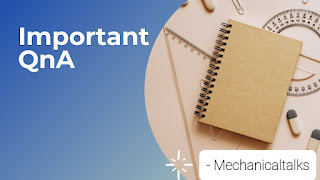Here are top 20 important MCQs of Industrial engineering. Read the questions carefully and try to answer all of them from your own.
Q1. A graphical device used to determine the break-even point and profit potential under varying conditions of output and costs, is known as
(a) flow chart
(b) Gnatt chart
(c) break-even chart
(d) PERT chart
(e) Taylor chart.
Q2. Break-even analysis consists of
(a) fixed cost
(b) fixed and variable costs
(c) variable coat
(d) operation costs
(e) none of the above.
Q3. Break-even analysis shows profit when (a) sales revenue > total cost
(b) sales revenue = total cost
(c) sales revenue < total cost
(d) variable cost < fixed cost
(e) none of the above
Q4. Break even point can be calculated by using the relation
(a) Fixed costs (F) / Variable costs (V)
(b) F/ 1-S/V
(c) F/ F-S/V
(d) F/ S/V-F
(e) can’t be determined.
Q5. Break-even point shows that
(a) sales revenue > total cost
(b) sales revenue < total cost
(c) sales revenue = total cost
(d) variable cost = fixed cost
(e) it does not relate the above costs.
Q6. In brack-even analysis, total cost consists of
(a) variable cost
(b) fixed cost
(c) fixed cost + variable cost
(d) fixed cost + variable cost + over-heads
(e) foxed cost + sales revenue.
Q7. The break-even point represents
(a) the most economical level of operation of any industry
(b) the time when unit can run without loss and profit
(e) time when industry will undergo loss
(d) the time when company can make maximum profits
(e) time for overhauling a plant.
Q8. TMU in method time measurement stands for
(a) time motion unit
(b) time measurement unit
(c) time movement unit
(d) technique measurement unit
(e) time method unit.
Q9. In the cost structure of a product, the selling price is determined by the factors such as
(a) sales turn over
(b) lowest cumpetitive price
(e) various elements of the cont
(d) buyers’ capability to pay
(e) all of the above.
Q10. Work study is concerned with
(a) improving present method and finding standard time
(b) motivation of workers
(c) improving production capability
(d) improving production planning and control
(e) all of the above.
Q11. Basic tool in work study is
(a) process chart
(b) planning chart
(c) stop watch
(d) graph paper
(e) analytical mind.
Q12. What does symbol ‘O’ imply in work study
(a) operation
(b) inspection
(el transport
(d) delay/temporary storage
(e) none of the above.
Q13. One time measurement unit ( TMU ) in method time measurement system equals
(a) 0.0001 minute
(b) 0.0006 minute
(c) 0.006 minute
(d) 0.001 minute
(e) 0.06 minute.
Q14. The difference between the time available to do the Job and the time required to do the job, is known as.
(a) event
(b) flood
(c) duration
(d) Constraint
Q15. What does symbol ‘D’ imply in work study?
(a) inspection
(b) transport
(c) delay/temporary storage
(d) permanent storage
(e) none of the above.
Q16. What does symbol ‘▽’ imply in work study
(al operation
(b) inspection
(c) delay/ temporary storage
(d) permanent storage
(e) none of the above.
Q17. Material handling in automobile industry is done by
(a) overhead crane
(b) belt conveyor
(c) trolley
(d) none of the above
(e) all of the above.
Q18. String diagram is used when
(a) team of workers is working at a place
(b) material handling is to be done
(c) idle time is to be reduced
(d) all of the above
(e) none of the above.
Q19. In micromotion study, therblig is described by
(a) A symbol
(b) an event
(c) an activity
(d) micro motions
(e) standard symbol and colour.
Q20. Gantt chart provides information about the
(a) material handling
(b) proper utilisation of manpower
(c) production schedule
(d) efficient working of machine
(e) all of the above.
That was the set 1 of top 20 important MCQs of Industrial engineering. This will help a lot for the upcoming competitive examinations like UPRVUNL, IGCAR, SAIL, NHPC. If you like this content then do share this with your well wishers. If you have any doubts regarding any mechanical engineering then let us know in comment section or contact us through email.
